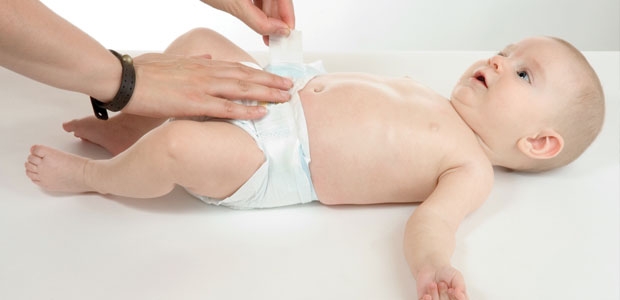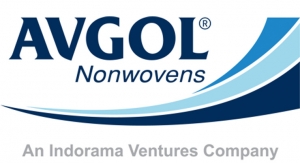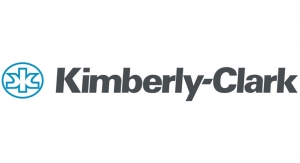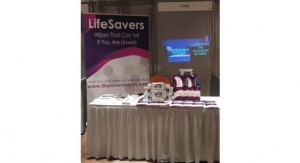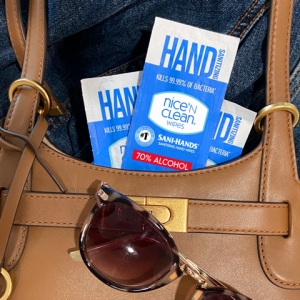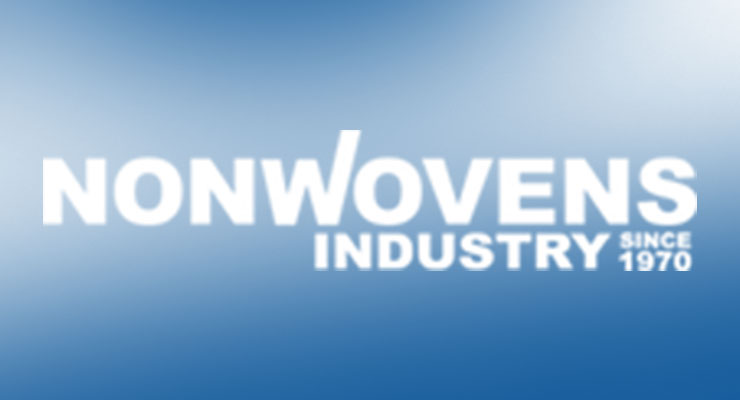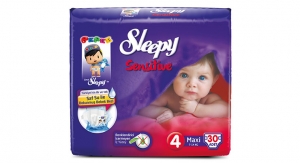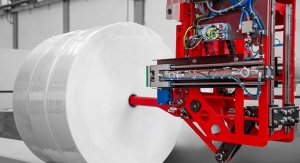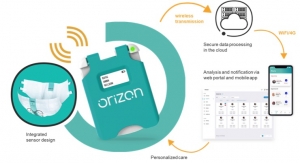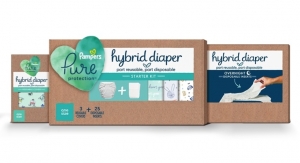Carlos Richer, Contributing Writer01.06.14
Since the mid 1990s when the “breathable diaper” was first launched, many brands of baby diapers have been using permeable laminated backsheets. The easiest way to manufacture such a laminate is by adding calcium carbonate, a very fine mineral just like talc. The CaCO3 powder is added to the PE pellets and homogeneously mixed before the blend is fed to a melting screw. Once the film is extruded, it is stretched using a group of rollers, while the film is still warm.
This stretching results in millions of micro holes that are made into the film (see Figure 1). This breathable film is laminated with a nonwoven sheet using hot melt, commonly referred to as “hot melt lamination breathable laminate”; or extruded directly into a nonwoven sheet, also called “melt embossed breathable laminate” in order to create the breathable textile backsheet that we know so well.
Typical weights for baby diaper textile backsheets range between 22 gsm for direct melt embossed extrusion to around 35gsm for hot melt lamination. The reason why direct extrusion can be done at lower gsms is because it is possible to handle the extruded film at very low gsms, even as low as 8 gsm or less. However, it is very difficult to unwind a finished roll of PE film at 8 gsm due to limitations in tension control equipment and the impossibility to unwind it in a diaper line. This forces the film, the one that is going to be unwinded for hot melt lamination, to almost twice the gage of direct extrusion.
This may seem like a big negative factor on hot melt lamination due to its higher costs, however, the feeling and the hand texture resulting from direct extrusion can not compare with the additional softness and cloth like feeling of a good lamination. Most people have to decide between the cost savings or the improved softness. Today, with the arrival of a new generation of PE resins, it is possible to obtain softer backsheets, much softer in comparison to what was available just a few years ago, and most likely it will keep improving as a result of current research in polymer technology.
The consumer most times is not able to detect the differences between a breathable backsheet and a non-breathable one, except maybe for the most trained eye and perhaps for the softer feeling that is added by the micro holes. It is a fact that most users of cloth-like backsheet, also known as textile backsheet or TBS, already think that the laminate used in the diaper is breathable, even when it is not. If this is the case, then why are breathable films used in the first place?
It has been confirmed by several medical research reports, specially those funded by large multinational diaper companies, that there is improved skin condition when the air is allowed to interact with the skin, instead of keeping it totally isolated by a non-breathable backsheet. One of the typical concerns of pediatricians when they encounter skin irritation in babies, is to suggest to the parents to allow the baby skin to breath for a few minutes between diaper changes; in addition to the use of skin barriers such as petrolatum or zinc oxide or some medications depending on the specific type of rash.
Using a breathable diaper, the air can go into the diaper when the diaper is dry, but it can also get in even when the diaper is wet. The same way, water vapor can get out from the diaper allowing for some evaporation of the urine. The skin benefit is not so much related to the ability of the diaper to dry itself even when this may help a bit, as much as the benefit of allowing the air to get to the skin. The amount of air that can go through the laminated backsheet depends on the density and size of the holes, as well as the thickness of the film. The most common way to measure this gas exchange is by using WVTR, the water vapor transmission rate in a day. There is a simple cup method used to measure the amount of water vapor that is lost through the laminate using standard laboratory conditions. The result of this weight loss is expressed as WVTR in gsm per day.
Why measure water vapor instead of air transmission rate? Well, one good reason may be because of our history. Water vapor was the most important concern with cereal packaging for a long time, way before diapers even existed. Without a good moisture barrier, the cereal lost the “crunchiness” and its texture. With time, those same tests started to be applied for everything else, not just cereal. It finally became the accepted standard for all kinds of barriers. It is important to note that there is a direct relationship between the water vapor and the air transmission rates, so we can say that a higher WVTR also means a higher air transmission rate, as well as a higher oxygen transmission rate.
What are the typical WVTR used in baby diapers? Table 1, shows the amount of WVTR that is most typically found in disposable baby diapers around the world; as you can see, it is a wide range.
What is important to know is that the higher the WVTR, the greater the amount of air getting into the diaper, but also the smell coming out of the diaper to the environment is the equivalent to a leakage of smell rather than a leakage of urine. As we will see, this new kind of leakage can be fortunate or unfortunate, depending on who is the audience.
You can spend good money educating consumers of the benefits of a breathable diaper, but if the resulting smell is not acceptable to parents, they will change brands and will stop buying your products. Several factors determine how much smell consumers accept. Probably the most important of all is the local culture and change of diaper frequency habits. For sure culture plays a major role on what is acceptable. In countries like Japan and South Korea, which are famous for having the highest rate of diaper changes in the world, consumers not only prefer a high WVTR backsheet, they will demand for it and would not even consider to buy a diaper that is not breathable. For them it is important to know when the diaper is wet so they can change the diaper as soon as possible, but also they want to make sure the skin is at the best and as dry as possible. They use their sense of smell as an additional indicator for diaper change, reducing the risk of diaper rash.
In many other regions, in particular in Latin America and the Middle East, as well as basically in all the emerging economies like India and African countries, consumers are more concerned with their economy rather than increasing diaper change frequency. They are unwilling to change the diaper just because it is wet; they continue to use it until it becomes almost fully saturated. In all these cases, smell can play a major role and it can produce a negative perception on consumer’s preferences. Instead of the welcoming effect of the smell, as a signal to change the diaper, for these consumers they associate the smell as a diaper with bad quality.
Contrary to popular belief, the smell of the diaper is not just because of the biodegradation process of the urine, which happens only after several hours that the diaper has been wet; it is also due to the very fresh urine. Several components in diaper urine, like many of its organic acids, have a bad smell; luckily for parents, the smell gets much worst with age, so it is a more serious issue when dealing with the urine from elderly people, than with most young kids. Nevertheless, the odor of baby urine is still strong enough to have a negative effect in diaper quality perception. Of course if the diaper also had a chance to biodegrade in order to produce ammonia, this is a more serious skin concern, but it is not as common as we may think, except for those warmer areas and long extended use.
In summary, what is the best amount of WVTR in a baby diaper? If you decide to use a higher WVTR, you will be probably be limited by surface condensation. Depending on the specific relative humidity and the temperature difference between the absorbent pad and the environment, you may end up experiencing condensation. This should be avoided. Condensation may happen at WVTRs as low as 10,000, but it is more common above 12,000. You should also be aware that at higher WVTRs you may create added discomfort associated to lower urine temperatures resulting from the evaporation. This in some cases, such as during wintertime, could be more negative than the positive effect of having a transfer of air to the skin.
Many babies wake up in the middle of the night not because the diaper leaked a few drops of urine, but because they feel cold. Many adult users have reported the same. I believe there is no sufficient research evidence on the topic of the interaction between skin health and skin comfort for a definite scientific answer. If you choose to go in the direction of a lower WVTR, you may end up with just a gimmick. As far as I know, there is no legislation anywhere in the world defining what should be the minimum amount of WVTR in order to qualify for a claim of breathability into the bag of baby diapers, but you may be missing potential benefits. How much is it really, how much has been exaggerated and how much can it be a negative due to the colder urine rewets is still a topic of future discussion and debate. A simple suggestion, try not to exceed the WVTR of the local market leader.
About the author
Carlos Richer is the principal at Richer Investment. He is a diaper industry consultant with 28 years experience in diaper manufacturing and is also the owner of The Disposable Diaper Network group at LinkedIn.
This stretching results in millions of micro holes that are made into the film (see Figure 1). This breathable film is laminated with a nonwoven sheet using hot melt, commonly referred to as “hot melt lamination breathable laminate”; or extruded directly into a nonwoven sheet, also called “melt embossed breathable laminate” in order to create the breathable textile backsheet that we know so well.
Typical weights for baby diaper textile backsheets range between 22 gsm for direct melt embossed extrusion to around 35gsm for hot melt lamination. The reason why direct extrusion can be done at lower gsms is because it is possible to handle the extruded film at very low gsms, even as low as 8 gsm or less. However, it is very difficult to unwind a finished roll of PE film at 8 gsm due to limitations in tension control equipment and the impossibility to unwind it in a diaper line. This forces the film, the one that is going to be unwinded for hot melt lamination, to almost twice the gage of direct extrusion.
This may seem like a big negative factor on hot melt lamination due to its higher costs, however, the feeling and the hand texture resulting from direct extrusion can not compare with the additional softness and cloth like feeling of a good lamination. Most people have to decide between the cost savings or the improved softness. Today, with the arrival of a new generation of PE resins, it is possible to obtain softer backsheets, much softer in comparison to what was available just a few years ago, and most likely it will keep improving as a result of current research in polymer technology.
The consumer most times is not able to detect the differences between a breathable backsheet and a non-breathable one, except maybe for the most trained eye and perhaps for the softer feeling that is added by the micro holes. It is a fact that most users of cloth-like backsheet, also known as textile backsheet or TBS, already think that the laminate used in the diaper is breathable, even when it is not. If this is the case, then why are breathable films used in the first place?
It has been confirmed by several medical research reports, specially those funded by large multinational diaper companies, that there is improved skin condition when the air is allowed to interact with the skin, instead of keeping it totally isolated by a non-breathable backsheet. One of the typical concerns of pediatricians when they encounter skin irritation in babies, is to suggest to the parents to allow the baby skin to breath for a few minutes between diaper changes; in addition to the use of skin barriers such as petrolatum or zinc oxide or some medications depending on the specific type of rash.
Using a breathable diaper, the air can go into the diaper when the diaper is dry, but it can also get in even when the diaper is wet. The same way, water vapor can get out from the diaper allowing for some evaporation of the urine. The skin benefit is not so much related to the ability of the diaper to dry itself even when this may help a bit, as much as the benefit of allowing the air to get to the skin. The amount of air that can go through the laminated backsheet depends on the density and size of the holes, as well as the thickness of the film. The most common way to measure this gas exchange is by using WVTR, the water vapor transmission rate in a day. There is a simple cup method used to measure the amount of water vapor that is lost through the laminate using standard laboratory conditions. The result of this weight loss is expressed as WVTR in gsm per day.
Why measure water vapor instead of air transmission rate? Well, one good reason may be because of our history. Water vapor was the most important concern with cereal packaging for a long time, way before diapers even existed. Without a good moisture barrier, the cereal lost the “crunchiness” and its texture. With time, those same tests started to be applied for everything else, not just cereal. It finally became the accepted standard for all kinds of barriers. It is important to note that there is a direct relationship between the water vapor and the air transmission rates, so we can say that a higher WVTR also means a higher air transmission rate, as well as a higher oxygen transmission rate.
What are the typical WVTR used in baby diapers? Table 1, shows the amount of WVTR that is most typically found in disposable baby diapers around the world; as you can see, it is a wide range.
What is important to know is that the higher the WVTR, the greater the amount of air getting into the diaper, but also the smell coming out of the diaper to the environment is the equivalent to a leakage of smell rather than a leakage of urine. As we will see, this new kind of leakage can be fortunate or unfortunate, depending on who is the audience.
You can spend good money educating consumers of the benefits of a breathable diaper, but if the resulting smell is not acceptable to parents, they will change brands and will stop buying your products. Several factors determine how much smell consumers accept. Probably the most important of all is the local culture and change of diaper frequency habits. For sure culture plays a major role on what is acceptable. In countries like Japan and South Korea, which are famous for having the highest rate of diaper changes in the world, consumers not only prefer a high WVTR backsheet, they will demand for it and would not even consider to buy a diaper that is not breathable. For them it is important to know when the diaper is wet so they can change the diaper as soon as possible, but also they want to make sure the skin is at the best and as dry as possible. They use their sense of smell as an additional indicator for diaper change, reducing the risk of diaper rash.
In many other regions, in particular in Latin America and the Middle East, as well as basically in all the emerging economies like India and African countries, consumers are more concerned with their economy rather than increasing diaper change frequency. They are unwilling to change the diaper just because it is wet; they continue to use it until it becomes almost fully saturated. In all these cases, smell can play a major role and it can produce a negative perception on consumer’s preferences. Instead of the welcoming effect of the smell, as a signal to change the diaper, for these consumers they associate the smell as a diaper with bad quality.
Contrary to popular belief, the smell of the diaper is not just because of the biodegradation process of the urine, which happens only after several hours that the diaper has been wet; it is also due to the very fresh urine. Several components in diaper urine, like many of its organic acids, have a bad smell; luckily for parents, the smell gets much worst with age, so it is a more serious issue when dealing with the urine from elderly people, than with most young kids. Nevertheless, the odor of baby urine is still strong enough to have a negative effect in diaper quality perception. Of course if the diaper also had a chance to biodegrade in order to produce ammonia, this is a more serious skin concern, but it is not as common as we may think, except for those warmer areas and long extended use.
In summary, what is the best amount of WVTR in a baby diaper? If you decide to use a higher WVTR, you will be probably be limited by surface condensation. Depending on the specific relative humidity and the temperature difference between the absorbent pad and the environment, you may end up experiencing condensation. This should be avoided. Condensation may happen at WVTRs as low as 10,000, but it is more common above 12,000. You should also be aware that at higher WVTRs you may create added discomfort associated to lower urine temperatures resulting from the evaporation. This in some cases, such as during wintertime, could be more negative than the positive effect of having a transfer of air to the skin.
Many babies wake up in the middle of the night not because the diaper leaked a few drops of urine, but because they feel cold. Many adult users have reported the same. I believe there is no sufficient research evidence on the topic of the interaction between skin health and skin comfort for a definite scientific answer. If you choose to go in the direction of a lower WVTR, you may end up with just a gimmick. As far as I know, there is no legislation anywhere in the world defining what should be the minimum amount of WVTR in order to qualify for a claim of breathability into the bag of baby diapers, but you may be missing potential benefits. How much is it really, how much has been exaggerated and how much can it be a negative due to the colder urine rewets is still a topic of future discussion and debate. A simple suggestion, try not to exceed the WVTR of the local market leader.
About the author
Carlos Richer is the principal at Richer Investment. He is a diaper industry consultant with 28 years experience in diaper manufacturing and is also the owner of The Disposable Diaper Network group at LinkedIn.

